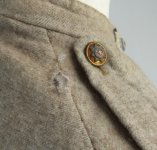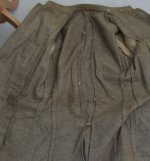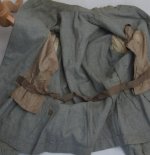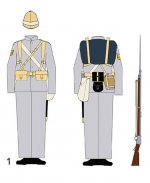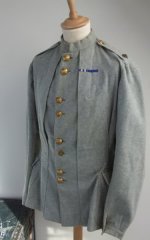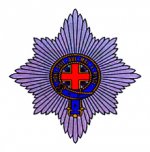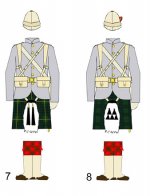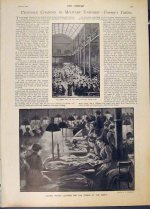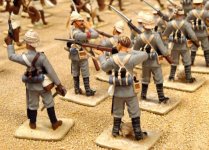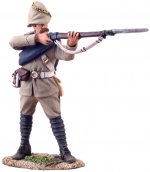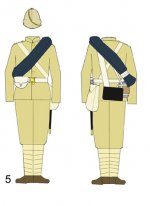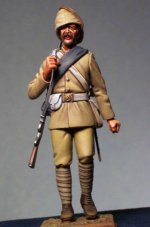You are using an out of date browser. It may not display this or other websites correctly.
You should upgrade or use an alternative browser.
You should upgrade or use an alternative browser.
Serge Grey Sudan Uniforms (1 Viewer)
- Thread starter PolarBear
- Start date
Ken & Ericka Osen/H&A Studio
Command Sergeant Major
- Joined
- Jun 22, 2005
- Messages
- 2,113
It seems like Martin has this pretty well in hand, but here are some comments for what it is worth.
For most of my adult life I have been searching out original uniforms and equipment for enlisted combat soldiers from many different countries and time periods. This is the material culture of any one organization at any given time .
There are always regulations outlining what soldiers are to wear, how and when. In some cases this has been realized by some countries for short periods or at the beginning of campaigns.
However there are always several factors to take into account that will effect the appearance of the troops in the field, and in some cases even in home service. It is both informative and frustrating to read period inspection returns for military organizations. They either state that everything is in good order or that something is too small, missing or not of the current pattern. I am sure that if we ever invent a way to have a widow on the past, or a time machine there will be plenty of disappointed or even surprised historians!
1. A new uniform change or escalation in world tension that will stress industry as it steps up production. This will mean that many manufacturers will become suppliers, beyond the usual approved sources.
2.Shortages of the accepted materials or content. I could go on forever here, but lets just consider a few...
The stress of expansion of the US Army combined with blockade during the War of 1812.
The expansion of the British Army during 1914-18 and the introduction of P14 suspension to supplement the P08.
WWII Whermacht uniforms... dye lots, fabric contents, details, decorations and even modification of cut between 1933 and 1945.
3. Different dye lots even at one source. Even with the industrial might of the United States in WWII, you can lay a line of M-1943 Field Jackets and see variations in lining color, body color, button colors, placement of wearing instruction labels
4. The effects of use, campaign or home service. There can be modifications at unit level such as tailoring to fit, modifications for end use or unit modifications. This may be the case with Highland units discussed.
Other effects include the effects of soiling, washing, wear and tear and most importantly... UV light. This latter fact can and will modify color of almost anything. An example here is that almost all 'Butternut' ACW uniforms were not butternut in color when the garments were made. This is a result of UV light exposure combined with the dyes and mordants used to set the dyes.
5. Now for my guess for the color in discussion at the moment. I would vote for a gray color on the warm side rather than a cold or blue tinged color. It just makes sense for the material used, the usual budget for Army goods, and similar materials used in later periods by the British army in gray. This seems to be a lightweight and cheap garment made by an Army contractor driven to maximize their profit. For aesthetic reasons I believe miniature painters have traditionally used a gray with a strong blue cast for this period. I would guess it to be more like an early twentieth century British enlisted man's wool shirt color.
6. As far as the Guards officer private purchase tunic... I would think that this confirms my guess. The interior color is probably as close as we will see in the near future to the color as I think it might have been.
It is too bad that this primary source item surfaced after the paint masters were produced for two different companies, but my guess for the W.B. Highlanders seems to be pretty close.
What I will say is that the train has left the station for both companies and any changes now would be probably be unacceptable to collectors.
Please do not see this as a rubber stamp for what might be right or wrong with anything... just my opinion based on an educated guess.
All the Best,
Ken
For most of my adult life I have been searching out original uniforms and equipment for enlisted combat soldiers from many different countries and time periods. This is the material culture of any one organization at any given time .
There are always regulations outlining what soldiers are to wear, how and when. In some cases this has been realized by some countries for short periods or at the beginning of campaigns.
However there are always several factors to take into account that will effect the appearance of the troops in the field, and in some cases even in home service. It is both informative and frustrating to read period inspection returns for military organizations. They either state that everything is in good order or that something is too small, missing or not of the current pattern. I am sure that if we ever invent a way to have a widow on the past, or a time machine there will be plenty of disappointed or even surprised historians!
1. A new uniform change or escalation in world tension that will stress industry as it steps up production. This will mean that many manufacturers will become suppliers, beyond the usual approved sources.
2.Shortages of the accepted materials or content. I could go on forever here, but lets just consider a few...
The stress of expansion of the US Army combined with blockade during the War of 1812.
The expansion of the British Army during 1914-18 and the introduction of P14 suspension to supplement the P08.
WWII Whermacht uniforms... dye lots, fabric contents, details, decorations and even modification of cut between 1933 and 1945.
3. Different dye lots even at one source. Even with the industrial might of the United States in WWII, you can lay a line of M-1943 Field Jackets and see variations in lining color, body color, button colors, placement of wearing instruction labels
4. The effects of use, campaign or home service. There can be modifications at unit level such as tailoring to fit, modifications for end use or unit modifications. This may be the case with Highland units discussed.
Other effects include the effects of soiling, washing, wear and tear and most importantly... UV light. This latter fact can and will modify color of almost anything. An example here is that almost all 'Butternut' ACW uniforms were not butternut in color when the garments were made. This is a result of UV light exposure combined with the dyes and mordants used to set the dyes.
5. Now for my guess for the color in discussion at the moment. I would vote for a gray color on the warm side rather than a cold or blue tinged color. It just makes sense for the material used, the usual budget for Army goods, and similar materials used in later periods by the British army in gray. This seems to be a lightweight and cheap garment made by an Army contractor driven to maximize their profit. For aesthetic reasons I believe miniature painters have traditionally used a gray with a strong blue cast for this period. I would guess it to be more like an early twentieth century British enlisted man's wool shirt color.
6. As far as the Guards officer private purchase tunic... I would think that this confirms my guess. The interior color is probably as close as we will see in the near future to the color as I think it might have been.
It is too bad that this primary source item surfaced after the paint masters were produced for two different companies, but my guess for the W.B. Highlanders seems to be pretty close.
What I will say is that the train has left the station for both companies and any changes now would be probably be unacceptable to collectors.
Please do not see this as a rubber stamp for what might be right or wrong with anything... just my opinion based on an educated guess.
All the Best,
Ken
PolarBear
Major
- Joined
- Feb 24, 2007
- Messages
- 6,706
Martin Tabony
Command Sergeant Major
- Joined
- Nov 6, 2009
- Messages
- 2,077
Even to this day with modern manufacturing and dyes there are differences in shade. Exchange a No2 dress jacket and the trousers have to go with it.
Here's a picture of one of the Army Clothing Department workshops of the time, it looks more like a far east sweatshop!
Martin
Here's a picture of one of the Army Clothing Department workshops of the time, it looks more like a far east sweatshop!
Martin
Attachments
Ken & Ericka Osen/H&A Studio
Command Sergeant Major
- Joined
- Jun 22, 2005
- Messages
- 2,113
Randy,
Please understand that the evidence I presented in my last posting supports the true impossibility of 'uniformity' the way we all like to perceive it.
Furthermore we must also accept that once any company commits to it's best guess in a historical reconstruction for the miniature industry it is in everyone's best interest not to change anything in mid production.
In the living history and reenactment hobby some units will make sure that all equipment in a larger unit will remain uniform even when new evidence will present conflicting evidence, at least until there is a general consensus to change. This is to maintain uniformity and balance the expense to change.
For a more realistic appearance with any larger grouping of figures, even ACW Federals, there should be color variations. With this said, my experience in the collectibles industry tells me that many collectors will not accept this. This uniformity is even more prevalent in traditional gloss collections thus our decision to go with the accepted color for the Redcoats Gloss.
Ken
Please understand that the evidence I presented in my last posting supports the true impossibility of 'uniformity' the way we all like to perceive it.
Furthermore we must also accept that once any company commits to it's best guess in a historical reconstruction for the miniature industry it is in everyone's best interest not to change anything in mid production.
In the living history and reenactment hobby some units will make sure that all equipment in a larger unit will remain uniform even when new evidence will present conflicting evidence, at least until there is a general consensus to change. This is to maintain uniformity and balance the expense to change.
For a more realistic appearance with any larger grouping of figures, even ACW Federals, there should be color variations. With this said, my experience in the collectibles industry tells me that many collectors will not accept this. This uniformity is even more prevalent in traditional gloss collections thus our decision to go with the accepted color for the Redcoats Gloss.
Ken
PolarBear
Major
- Joined
- Feb 24, 2007
- Messages
- 6,706
My investigation into the color of the uniforms was motivated by Richard Walker's remark to me when I was writing the text for the Limited Edition Camel Corps Medic that material evidence for the uniforms was hard to come by. Since then, as a professional researcher, I have made a conscious effort to find an actual uniform in serge grey from that period. I am indebted to the collectors at the Victorian Wars Forum for providing this added information to my research. The paint master for 44042 is way too blue and I was hoping it might be toned down before it hits the dealers' shelves. I will probably have the tunic repainted on one of them to conform with my findings. This is what Konrad (kogu) did with the WB AWI Highlanders that were incorrectly painted at the factory in China with burgundy tunics rather than the traditional scarlet.
The Breaker
Corporal
- Joined
- Sep 28, 2007
- Messages
- 445
Polarbear,
I greatly appreciate the research you have provided. Especially the photos of the existing Coldstream Guards tunics. I think the research you have listed including the Coldstream Guards gray tunic confirms that the color for the matte WB Highlanders is right on. That is of course if the same manufacturer produced tunics for the Camel Corps, the Highlanders and Royal Marines.
I greatly appreciate the research you have provided. Especially the photos of the existing Coldstream Guards tunics. I think the research you have listed including the Coldstream Guards gray tunic confirms that the color for the matte WB Highlanders is right on. That is of course if the same manufacturer produced tunics for the Camel Corps, the Highlanders and Royal Marines.
Martin Tabony
Command Sergeant Major
- Joined
- Nov 6, 2009
- Messages
- 2,077
My investigation into the color of the uniforms was motivated by Richard Walker's remark to me when I was writing the text for the Limited Edition Camel Corps Medic that material evidence for the uniforms was hard to come by. Since then, as a professional researcher, I have made a conscious effort to find an actual uniform in serge grey from that period. I am indebted to the collectors at the Victorian Wars Forum for providing this added information to my research. The paint master for 44042 is way too blue and I was hoping it might be toned down before it hits the dealers' shelves. I will probably have the tunic repainted on one of them to conform with my findings. This is what Konrad (kogu) did with the WB AWI Highlanders that were incorrectly painted at the factory in China with burgundy tunics rather than the traditional scarlet.
I think you're just about to open another can of worms! British infantry red. I've heard lots of debates over the years about modern scarlet versus brick red. It's only about five years ago that it was decided by the powers that be,to make the Foot Guards tunic "more red". As I've already said I'd like to see a uniforms thread. I'm always happy to learn something new, I know very little about "butternut".
By the way the colour I've been using is Americana DA111 Grey Sky in the photos from the London show they look more blue than the actual figures.
Martin
DMNamiot
Moderator
- Joined
- Apr 29, 2005
- Messages
- 4,336
Hi Guys,
In support of Ken's statement on the color variations in uniforms I saw this quiet often while I was in the Army. In any given formation with all of soldiers available for that formation you would see a wide variation in the patterns and colors of the BDU's if a soldier had been in a while his uniforms might be deeply faded due to the UV and harshness of the weather in general. We also had one set of uniforms that were horrible due to the poor quality of the dyes used by the maker, a couple of washings and they were worn out. But when these uniforms were brand new on the shelf in the clothing sales you couldnt tell the difference. I guess the point I want to make is the uniforms today are just as varried as they likely were over 100 years ago.
I really enjoy these discussions and the information Randy provides is very handy, but unless we get real lucky and someone finds a warehouse stash of these grey uniforms hidden away in sealed crates I doubt we will really be able to put this one to bed. Still the photos of the Officers Uniform is wonderful and it appears to be in excellent shape. So for future figures at least we have a decent color guide of the painters.
Dave
In support of Ken's statement on the color variations in uniforms I saw this quiet often while I was in the Army. In any given formation with all of soldiers available for that formation you would see a wide variation in the patterns and colors of the BDU's if a soldier had been in a while his uniforms might be deeply faded due to the UV and harshness of the weather in general. We also had one set of uniforms that were horrible due to the poor quality of the dyes used by the maker, a couple of washings and they were worn out. But when these uniforms were brand new on the shelf in the clothing sales you couldnt tell the difference. I guess the point I want to make is the uniforms today are just as varried as they likely were over 100 years ago.
I really enjoy these discussions and the information Randy provides is very handy, but unless we get real lucky and someone finds a warehouse stash of these grey uniforms hidden away in sealed crates I doubt we will really be able to put this one to bed. Still the photos of the Officers Uniform is wonderful and it appears to be in excellent shape. So for future figures at least we have a decent color guide of the painters.
Dave
Martin Tabony
Command Sergeant Major
- Joined
- Nov 6, 2009
- Messages
- 2,077
martin
when i brought the red issue up to ken several years ago he fully described the wide variation in red fabrics in the 18th and 19th centuries. But the awi highlanders tunics verged on being purple.
Oh oh
Martin Tabony
Command Sergeant Major
- Joined
- Nov 6, 2009
- Messages
- 2,077
Hi Guys,
In support of Ken's statement on the color variations in uniforms I saw this quiet often while I was in the Army. In any given formation with all of soldiers available for that formation you would see a wide variation in the patterns and colors of the BDU's if a soldier had been in a while his uniforms might be deeply faded due to the UV and harshness of the weather in general. We also had one set of uniforms that were horrible due to the poor quality of the dyes used by the maker, a couple of washings and they were worn out. But when these uniforms were brand new on the shelf in the clothing sales you couldnt tell the difference. I guess the point I want to make is the uniforms today are just as varried as they likely were over 100 years ago.
I really enjoy these discussions and the information Randy provides is very handy, but unless we get real lucky and someone finds a warehouse stash of these grey uniforms hidden away in sealed crates I doubt we will really be able to put this one to bed. Still the photos of the Officers Uniform is wonderful and it appears to be in excellent shape. So for future figures at least we have a decent color guide of the painters.
Dave
Faded uniforms are the best way to identify the "old sweat".
I remember our first issue of high leg boots were withdrawn when the soles fell off in contact with horse urine!
aujj65
Colonel
- Joined
- Sep 30, 2005
- Messages
- 9,153
I think you're just about to open another can of worms! British infantry red. I've heard lots of debates over the years about modern scarlet versus brick red. It's only about five years ago that it was decided by the powers that be,to make the Foot Guards tunic "more red". As I've already said I'd like to see a uniforms thread. I'm always happy to learn something new, I know very little about "butternut".
By the way the colour I've been using is Americana DA111 Grey Sky in the photos from the London show they look more blue than the actual figures.
Martin
Martin,
I take it these are the ones you are referring to. I think they are grey and look fine.
Jeff
Attachments
Martin Tabony
Command Sergeant Major
- Joined
- Nov 6, 2009
- Messages
- 2,077
Martin,
I take it these are the ones you are referring to. I think they are grey and look fine.
Jeff
See now I'm wondering if it's my monitor! Can't win
PolarBear
Major
- Joined
- Feb 24, 2007
- Messages
- 6,706
Note these WB figures in the Sudan series look like serge grey or are they Indian khaki? I believe they arrived in Egypt from being posted to India so most likely khaki (see Perry illustration). Like Martin says monitors differ
27025 - BRITISH YORK AND LANCASTER REGIMENT STANDING FIRING #1
27025 - BRITISH YORK AND LANCASTER REGIMENT STANDING FIRING #1
Attachments
Martin Tabony
Command Sergeant Major
- Joined
- Nov 6, 2009
- Messages
- 2,077
Note these WB figures in the Sudan series look like serge grey or are they Indian khaki? I believe they arrived in Egypt from being posted to India so most likely khaki (see Perry illustration). Like Martin says monitors differ
27025 - BRITISH YORK AND LANCASTER REGIMENT STANDING FIRING #1
Indian khaki and 57 pattern equipment. Basicaly the same as was worn in Afganistan 1879/80.
Martin
Ken & Ericka Osen/H&A Studio
Command Sergeant Major
- Joined
- Jun 22, 2005
- Messages
- 2,113
Hi All!
This figure is in cotton Khaki and was painted to represent that. Remember that this unit was issued their uniforms in India, so we had Dave paint it slightly faded.
Also remember that the use of modern illustrations such as the war game color guide as produced by the Perry brothers or a 1/6th scale reconstruction are secondary sources. We do our own research and draw our own conclusions. This is not to discount the work of other reconstructions... it just means we draw our own conclusions, in some cases from the same primary sources.
What shade is Khaki on campaign?
Any WWII color photos of combat in North Africa or the Russian front and all of the cotton British, German, Italian or Soviet uniforms will show a bewildering variety depending on source, dyelot and length of use.
This was our best guess... again refer to the postings by Martin and Dave and this reflects twentieth century organizations!
Hope this helps,
Ken
This figure is in cotton Khaki and was painted to represent that. Remember that this unit was issued their uniforms in India, so we had Dave paint it slightly faded.
Also remember that the use of modern illustrations such as the war game color guide as produced by the Perry brothers or a 1/6th scale reconstruction are secondary sources. We do our own research and draw our own conclusions. This is not to discount the work of other reconstructions... it just means we draw our own conclusions, in some cases from the same primary sources.
What shade is Khaki on campaign?
Any WWII color photos of combat in North Africa or the Russian front and all of the cotton British, German, Italian or Soviet uniforms will show a bewildering variety depending on source, dyelot and length of use.
This was our best guess... again refer to the postings by Martin and Dave and this reflects twentieth century organizations!
Hope this helps,
Ken
PolarBear
Major
- Joined
- Feb 24, 2007
- Messages
- 6,706
Users who are viewing this thread
Total: 2 (members: 0, guests: 2)


